Bai Li
UAVs Meet LLMs: Overviews and Perspectives Toward Agentic Low-Altitude Mobility
Jan 04, 2025Abstract:Low-altitude mobility, exemplified by unmanned aerial vehicles (UAVs), has introduced transformative advancements across various domains, like transportation, logistics, and agriculture. Leveraging flexible perspectives and rapid maneuverability, UAVs extend traditional systems' perception and action capabilities, garnering widespread attention from academia and industry. However, current UAV operations primarily depend on human control, with only limited autonomy in simple scenarios, and lack the intelligence and adaptability needed for more complex environments and tasks. The emergence of large language models (LLMs) demonstrates remarkable problem-solving and generalization capabilities, offering a promising pathway for advancing UAV intelligence. This paper explores the integration of LLMs and UAVs, beginning with an overview of UAV systems' fundamental components and functionalities, followed by an overview of the state-of-the-art in LLM technology. Subsequently, it systematically highlights the multimodal data resources available for UAVs, which provide critical support for training and evaluation. Furthermore, it categorizes and analyzes key tasks and application scenarios where UAVs and LLMs converge. Finally, a reference roadmap towards agentic UAVs is proposed, aiming to enable UAVs to achieve agentic intelligence through autonomous perception, memory, reasoning, and tool utilization. Related resources are available at https://github.com/Hub-Tian/UAVs_Meet_LLMs.
Milestones in Autonomous Driving and Intelligent Vehicles Part II: Perception and Planning
Jun 03, 2023



Abstract:Growing interest in autonomous driving (AD) and intelligent vehicles (IVs) is fueled by their promise for enhanced safety, efficiency, and economic benefits. While previous surveys have captured progress in this field, a comprehensive and forward-looking summary is needed. Our work fills this gap through three distinct articles. The first part, a "Survey of Surveys" (SoS), outlines the history, surveys, ethics, and future directions of AD and IV technologies. The second part, "Milestones in Autonomous Driving and Intelligent Vehicles Part I: Control, Computing System Design, Communication, HD Map, Testing, and Human Behaviors" delves into the development of control, computing system, communication, HD map, testing, and human behaviors in IVs. This part, the third part, reviews perception and planning in the context of IVs. Aiming to provide a comprehensive overview of the latest advancements in AD and IVs, this work caters to both newcomers and seasoned researchers. By integrating the SoS and Part I, we offer unique insights and strive to serve as a bridge between past achievements and future possibilities in this dynamic field.
Milestones in Autonomous Driving and Intelligent Vehicles: Survey of Surveys
Mar 30, 2023



Abstract:Interest in autonomous driving (AD) and intelligent vehicles (IVs) is growing at a rapid pace due to the convenience, safety, and economic benefits. Although a number of surveys have reviewed research achievements in this field, they are still limited in specific tasks, lack of systematic summary and research directions in the future. Here we propose a Survey of Surveys (SoS) for total technologies of AD and IVs that reviews the history, summarizes the milestones, and provides the perspectives, ethics, and future research directions. To our knowledge, this article is the first SoS with milestones in AD and IVs, which constitutes our complete research work together with two other technical surveys. We anticipate that this article will bring novel and diverse insights to researchers and abecedarians, and serve as a bridge between past and future.
* 13 pages, 3 tables, 0 figure
Motion Planning for Autonomous Driving: The State of the Art and Future Perspectives
Mar 29, 2023



Abstract:Thanks to the augmented convenience, safety advantages, and potential commercial value, Intelligent vehicles (IVs) have attracted wide attention throughout the world. Although a few autonomous driving unicorns assert that IVs will be commercially deployable by 2025, their implementation is still restricted to small-scale validation due to various issues, among which precise computation of control commands or trajectories by planning methods remains a prerequisite for IVs. This paper aims to review state-of-the-art planning methods, including pipeline planning and end-to-end planning methods. In terms of pipeline methods, a survey of selecting algorithms is provided along with a discussion of the expansion and optimization mechanisms, whereas in end-to-end methods, the training approaches and verification scenarios of driving tasks are points of concern. Experimental platforms are reviewed to facilitate readers in selecting suitable training and validation methods. Finally, the current challenges and future directions are discussed. The side-by-side comparison presented in this survey not only helps to gain insights into the strengths and limitations of the reviewed methods but also assists with system-level design choices.
Embodied Footprints: A Safety-guaranteed Collision Avoidance Model for Numerical Optimization-based Trajectory Planning
Feb 15, 2023Abstract:Numerical optimization-based methods are among the prevalent trajectory planners for autonomous driving. In a numerical optimization-based planner, the nominal continuous-time trajectory planning problem is discretized into a nonlinear program (NLP) problem with finite constraints imposed on finite collocation points. However, constraint violations between adjacent collocation points may still occur. This study proposes a safety-guaranteed collision-avoidance modeling method to eliminate the collision risks between adjacent collocation points in using numerical optimization-based trajectory planners. A new concept called embodied box is proposed, which is formed by enlarging the rectangular footprint of the ego vehicle. If one can ensure that the embodied boxes at finite collocation points are collide-free, then the ego vehicle's footprint is collide-free at any a moment between adjacent collocation points. We find that the geometric size of an embodied box is a simple function of vehicle velocity and curvature. The proposed theory lays a foundation for numerical optimization-based trajectory planners in autonomous driving.
Integrating Linguistic Theory and Neural Language Models
Jul 20, 2022



Abstract:Transformer-based language models have recently achieved remarkable results in many natural language tasks. However, performance on leaderboards is generally achieved by leveraging massive amounts of training data, and rarely by encoding explicit linguistic knowledge into neural models. This has led many to question the relevance of linguistics for modern natural language processing. In this dissertation, I present several case studies to illustrate how theoretical linguistics and neural language models are still relevant to each other. First, language models are useful to linguists by providing an objective tool to measure semantic distance, which is difficult to do using traditional methods. On the other hand, linguistic theory contributes to language modelling research by providing frameworks and sources of data to probe our language models for specific aspects of language understanding. This thesis contributes three studies that explore different aspects of the syntax-semantics interface in language models. In the first part of my thesis, I apply language models to the problem of word class flexibility. Using mBERT as a source of semantic distance measurements, I present evidence in favour of analyzing word class flexibility as a directional process. In the second part of my thesis, I propose a method to measure surprisal at intermediate layers of language models. My experiments show that sentences containing morphosyntactic anomalies trigger surprisals earlier in language models than semantic and commonsense anomalies. Finally, in the third part of my thesis, I adapt several psycholinguistic studies to show that language models contain knowledge of argument structure constructions. In summary, my thesis develops new connections between natural language processing, linguistic theory, and psycholinguistics to provide fresh perspectives for the interpretation of language models.
On the data requirements of probing
Feb 25, 2022



Abstract:As large and powerful neural language models are developed, researchers have been increasingly interested in developing diagnostic tools to probe them. There are many papers with conclusions of the form "observation X is found in model Y", using their own datasets with varying sizes. Larger probing datasets bring more reliability, but are also expensive to collect. There is yet to be a quantitative method for estimating reasonable probing dataset sizes. We tackle this omission in the context of comparing two probing configurations: after we have collected a small dataset from a pilot study, how many additional data samples are sufficient to distinguish two different configurations? We present a novel method to estimate the required number of data samples in such experiments and, across several case studies, we verify that our estimations have sufficient statistical power. Our framework helps to systematically construct probing datasets to diagnose neural NLP models.
Neural reality of argument structure constructions
Feb 24, 2022

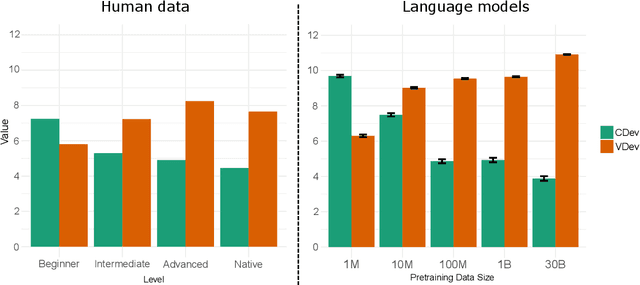
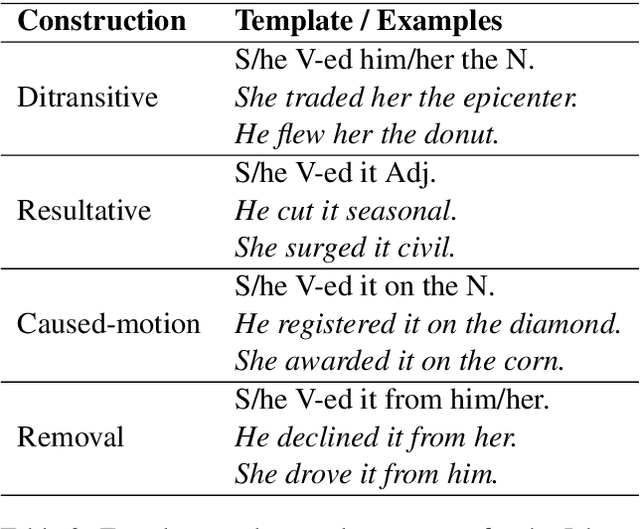
Abstract:In lexicalist linguistic theories, argument structure is assumed to be predictable from the meaning of verbs. As a result, the verb is the primary determinant of the meaning of a clause. In contrast, construction grammarians propose that argument structure is encoded in constructions (or form-meaning pairs) that are distinct from verbs. Decades of psycholinguistic research have produced substantial empirical evidence in favor of the construction view. Here we adapt several psycholinguistic studies to probe for the existence of argument structure constructions (ASCs) in Transformer-based language models (LMs). First, using a sentence sorting experiment, we find that sentences sharing the same construction are closer in embedding space than sentences sharing the same verb. Furthermore, LMs increasingly prefer grouping by construction with more input data, mirroring the behaviour of non-native language learners. Second, in a "Jabberwocky" priming-based experiment, we find that LMs associate ASCs with meaning, even in semantically nonsensical sentences. Our work offers the first evidence for ASCs in LMs and highlights the potential to devise novel probing methods grounded in psycholinguistic research.
What do writing features tell us about AI papers?
Jul 13, 2021



Abstract:As the numbers of submissions to conferences grow quickly, the task of assessing the quality of academic papers automatically, convincingly, and with high accuracy attracts increasing attention. We argue that studying interpretable dimensions of these submissions could lead to scalable solutions. We extract a collection of writing features, and construct a suite of prediction tasks to assess the usefulness of these features in predicting citation counts and the publication of AI-related papers. Depending on the venues, the writing features can predict the conference vs. workshop appearance with F1 scores up to 60-90, sometimes even outperforming the content-based tf-idf features and RoBERTa. We show that the features describe writing style more than content. To further understand the results, we estimate the causal impact of the most indicative features. Our analysis on writing features provides a perspective to assessing and refining the writing of academic articles at scale.
How is BERT surprised? Layerwise detection of linguistic anomalies
May 16, 2021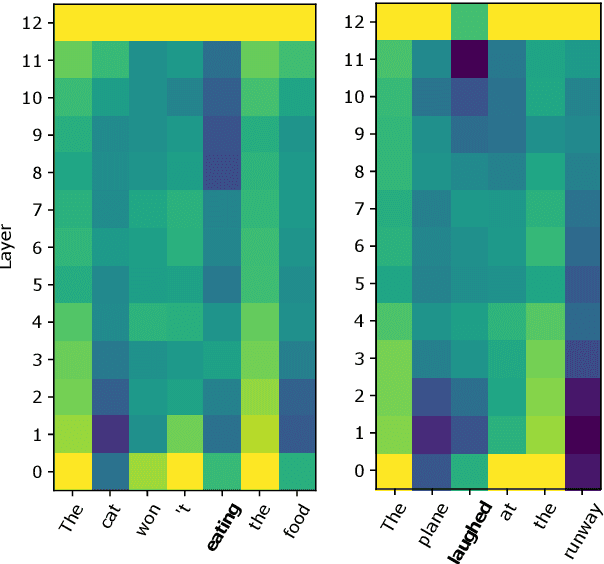
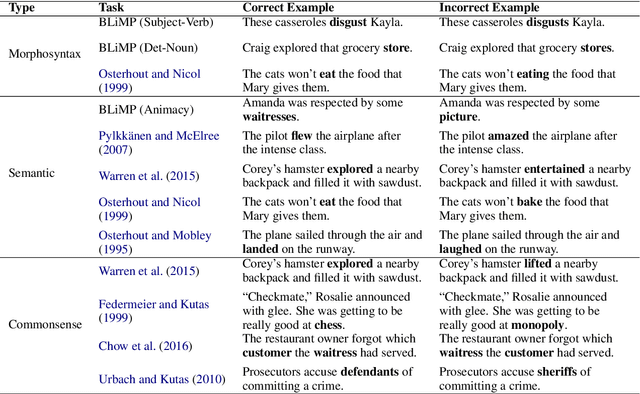

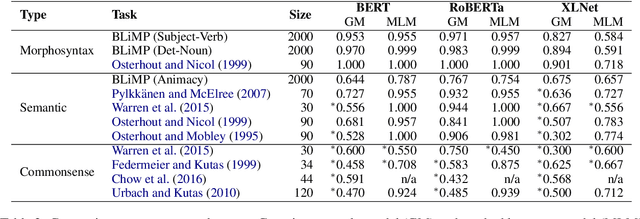
Abstract:Transformer language models have shown remarkable ability in detecting when a word is anomalous in context, but likelihood scores offer no information about the cause of the anomaly. In this work, we use Gaussian models for density estimation at intermediate layers of three language models (BERT, RoBERTa, and XLNet), and evaluate our method on BLiMP, a grammaticality judgement benchmark. In lower layers, surprisal is highly correlated to low token frequency, but this correlation diminishes in upper layers. Next, we gather datasets of morphosyntactic, semantic, and commonsense anomalies from psycholinguistic studies; we find that the best performing model RoBERTa exhibits surprisal in earlier layers when the anomaly is morphosyntactic than when it is semantic, while commonsense anomalies do not exhibit surprisal at any intermediate layer. These results suggest that language models employ separate mechanisms to detect different types of linguistic anomalies.
 Add to Chrome
Add to Chrome Add to Firefox
Add to Firefox Add to Edge
Add to Edge